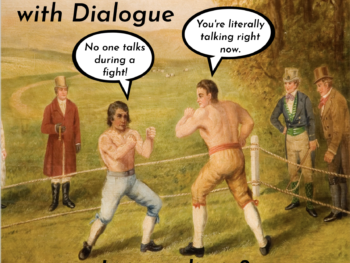Deception is manipulating the thoughts or feelings of others for personal gain. And, no matter how good our characters might be at deceiving others, they will always give clues to their duplicity. In this post we will look at how deception can be revealed through the very words our characters use to conceal it. To understand how that deception might be revealed, we have to understand how deceiving relates to running from bears.
What is Deception
Deception is not lying. In fact, the best deception involves truth which is why it is a vital tool in the fighter’s tool chest. Deception is why boxers use combinations of punches. The first punches distract the opponent. They cause the opponent to defend and move in such a way that makes them more vulnerable to the punches that follow. All of those punches are real, or, true. But, what those first punches aim to do, literally, isn’t so much land as control the focus of the opponent and move them in a way that benefits the one throwing the punches.
Like punch combos, verbal deception can manipulate the focus and thought movement of others. This ultimately makes listeners more vulnerable to the deception. In essence, deception is passive aggressive combat. From behind its shield of manipulation, the deceiver can flee or fight a perceived threat. In fact, deception is directly related to our threat response as much as freezing, fleeing or physical engagement.
Deception and the Limbic System
Our limbic system aims to maintain our physical survival. It does so by keeping record of our heightened emotional states such as joy or fear. When we experience these emotions again, our amygdala applies previous emotional memories that are similar so that our body knows whether to jump up and down happily, or run scream in terror. So, if we are in the woods and run into a bear, our bodies don’t so much see it as a threat as feel it is a threat.
When our brain perceives a threat through spoken or written communication, our threat response may compel us to deceive. That deception is an attempt to put distance between us and the painful outcome that might be attached to our telling the truth. Lying is the flight response in action. That is not to say that lying is beyond our control. It is to explain why our first instinct might be to lie and why some choose to do so.
The problem for those attempting to deceive as a threat response is that the limbic system isn’t designed to hide its excited state. That isn’t in keeping with survival. We aren’t meant to hide our fear when a bear is chasing us. We are just meant to run.
Deceptive Communication Patterns
These are certain communication patterns that, statistically, signal deception. Those signals are created by the limbic system and are beyond our control. That is not to say that someone who speaks like this is attempting to lie or deceive. They may communicate that way simply because they are nervous and their limbic system is sounding the alarm. But, in our writing, these are red flags that a character will inevitably show and other characters might want to look for. If you ever watch interrogation shows, you will see these patterns.
- Narrative balance – Recalling an event tends to have three parts. We give backstory to the event, talk about the event, and then sum things up. The greatest number of words tend to be about the event. “I was on my way to work (backstory) and I saw three guys run out of the bank. They had their faces covered and they got into a light-colored car but I don’t remember what kind (event). It happened really fast. I still can’t believe it. (summary).”
People who are being deceptive tend to give the greatest number of words to the backstory. “I was on my way to work. I have been late twice and I was afraid I would lose my job so I left early. I remember the clock on my dash showing 8:03. Lots of traffic that day. So, I’m at a stop light (backstory) and I see three guys run out of the bank. They got in a car and that’s it (event). That’s all I saw. (summary).” There is also another issue in that account that can speak to deception.
- Problems with Verb Tense – When recounting a past event, the present tense can be a problem. When telling the truth, people tend to talk about past events in the past tense. When being deceptive, people tend to mix in the present tense. The assumption is that those trying to deceive are creating those events in their mind, in present time, as they say them[i]. “I was walking through the parking lot after work. It was pretty empty. There were maybe a few other cars out there. Then this guy jumps out of nowhere and yells that he has a gun and tells me to give him I wallet. Then he just runs”
- Use of Many Negative Emotional Words – Negative emotional words when describing an event are normal. But when there is an excess, carefully observe it. For example, “I’d have to be a repulsive, worthless, disgusting freak to do that,” versus, “I wouldn’t do that. That’s disgusting.”
- Overly Specific – Sometimes those attempting to deceive will make their response very technical that brings in wording that a lay person might not understand.
“Did you go to the Clunker Auto Parts Store on Thursday?”
“That’s a good question. I’ve been having issues with the manifold gasket of my car. I would definitely fail an admissions test. Although it’s a ’95 so, you know, those standards are different. I needed a new inlet so I ran to get one.”
Another type of overly specific response provides facts or information that only pertain to one portion of the question. The hope is that in answering one part of the question, the one asking feels as though the entire question has been answered. Often this type of response is more telling in what it leaves out not in what it offers.
“Did you go to the Clunker Auto Parts Store on Thursday?”
“I didn’t drive there, no.”
The character doesn’t answer the actual question. Instead, they focus on an aspect of it. And, that character may not be lying. Maybe he didn’t drive there. Maybe his buddy drove him.
In our next post, we will go over a few more signs of deception in word communication. Between now and then, I hope you look for these deceptive communication methods in live footage. And, see if you can pick up on any other cues. In both cases, send me a message through the contact form and let me know what you saw and where you saw it. I love examples! By the way, there are several chapters on limbic language in my new book, FightWrite, Round Two: Crafting Chaos, Combat and Crime.
Until the next round with FightWrite, get blood on your pages.
[i] https://www.fraud-magazine.com/article.aspx?id=4294971184














96msn7
zhkc07
I haven?¦t checked in here for a while since I thought it was getting boring, but the last several posts are great quality so I guess I?¦ll add you back to my daily bloglist. You deserve it my friend 🙂
8z8xp1
e7fblo
r6ltc0
xzn9xx
Very nice pattern and excellent subject matter, very little else we want : D.
p4pev3
I think this is among the most significant information for me. And i’m glad reading your article. But wanna remark on few general things, The site style is great, the articles is really excellent : D. Good job, cheers
I’m so happy to read this. This is the kind of manual that needs to be given and not the accidental misinformation that is at the other blogs. Appreciate your sharing this best doc.
I like this website so much, saved to favorites. “I don’t care what is written about me so long as it isn’t true.” by Dorothy Parker.
Simply desire to say your article is as amazing. The clarity in your post is just spectacular and i can assume you are an expert on this subject. Fine with your permission allow me to grab your feed to keep up to date with forthcoming post. Thanks a million and please carry on the gratifying work.
I have recently started a website, the info you provide on this website has helped me tremendously. Thanks for all of your time & work. “So full of artless jealousy is guilt, It spills itself in fearing to be spilt.” by William Shakespeare.
Hello! This is my first comment here so I just wanted to give a quick shout out and say I genuinely enjoy reading through your blog posts. Can you suggest any other blogs/websites/forums that deal with the same topics? Thanks!
I got what you intend,saved to my bookmarks, very nice website .
Hello there, just become aware of your weblog via Google, and located that it is really informative. I am gonna watch out for brussels. I will be grateful in the event you proceed this in future. A lot of folks will likely be benefited out of your writing. Cheers!
There are certainly quite a lot of particulars like that to take into consideration. That is a nice point to convey up. I offer the ideas above as general inspiration but clearly there are questions just like the one you deliver up where an important factor will likely be working in trustworthy good faith. I don?t know if greatest practices have emerged round things like that, but I am certain that your job is clearly identified as a fair game. Both boys and girls feel the impact of only a moment’s pleasure, for the rest of their lives.
What’s Happening i am new to this, I stumbled upon this I have discovered It absolutely useful and it has helped me out loads. I hope to give a contribution & help other users like its aided me. Good job.
Great write-up, I am regular visitor of one’s blog, maintain up the nice operate, and It’s going to be a regular visitor for a long time.
Hiya, I am really glad I have found this information. Today bloggers publish only about gossips and web and this is really frustrating. A good website with exciting content, that is what I need. Thank you for keeping this web site, I’ll be visiting it. Do you do newsletters? Can’t find it.
Can I just say what a relief to find someone who actually knows what theyre talking about on the internet. You definitely know how to bring an issue to light and make it important. More people need to read this and understand this side of the story. I cant believe youre not more popular because you definitely have the gift.
I truly appreciate this post. I’ve been looking everywhere for this! Thank goodness I found it on Bing. You’ve made my day! Thanks again
I am not sure where you’re getting your information, but good topic. I needs to spend some time learning more or understanding more. Thanks for fantastic info I was looking for this info for my mission.
Hello there, I discovered your blog via Google at the same time as searching for a similar matter, your site came up, it seems to be great. I’ve bookmarked it in my google bookmarks.
I am constantly browsing online for articles that can aid me. Thanks!
Pretty nice post. I just stumbled upon your weblog and wanted to say that I’ve truly enjoyed browsing your blog posts. In any case I’ll be subscribing to your feed and I hope you write again very soon!
Hi, I think your site might be having browser compatibility issues. When I look at your website in Safari, it looks fine but when opening in Internet Explorer, it has some overlapping. I just wanted to give you a quick heads up! Other then that, fantastic blog!
Hey, you used to write great, but the last several posts have been kinda boringK I miss your tremendous writings. Past few posts are just a little bit out of track! come on!
We’re a gaggle of volunteers and starting a brand new scheme in our community. Your website offered us with helpful information to paintings on. You have done a formidable activity and our entire neighborhood will likely be grateful to you.
Some genuinely marvellous work on behalf of the owner of this web site, utterly great content.
It?¦s in point of fact a nice and useful piece of information. I?¦m happy that you just shared this helpful information with us. Please keep us up to date like this. Thanks for sharing.
I think this is one of the most vital info for me. And i’m satisfied studying your article. However should observation on few general things, The website style is wonderful, the articles is really excellent : D. Good activity, cheers
I have been browsing online more than three hours today, yet I never found any interesting article like yours. It’s pretty worth enough for me. In my view, if all webmasters and bloggers made good content as you did, the net will be much more useful than ever before.
When I originally commented I clicked the -Notify me when new comments are added- checkbox and now each time a comment is added I get four emails with the same comment. Is there any way you can remove me from that service? Thanks!
I do love the way you have presented this particular challenge plus it does indeed give me some fodder for thought. Nonetheless, coming from just what I have observed, I just simply trust when the actual feedback pile on that folks remain on point and don’t embark upon a soap box involving some other news du jour. Anyway, thank you for this excellent point and even though I can not go along with it in totality, I value the perspective.
Wow, marvelous blog layout! How long have you been blogging for? you make blogging look easy. The overall look of your website is fantastic, as well as the content!
Do you mind if I quote a few of your articles as long as I provide credit and sources back to your webpage? My website is in the very same area of interest as yours and my visitors would definitely benefit from some of the information you provide here. Please let me know if this okay with you. Many thanks!